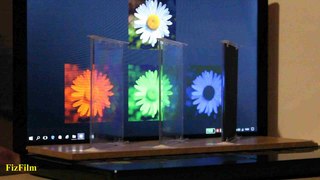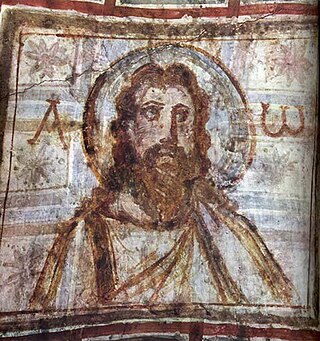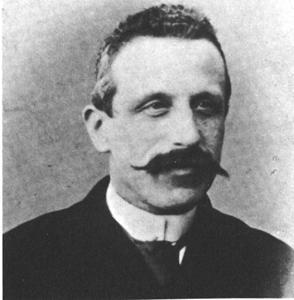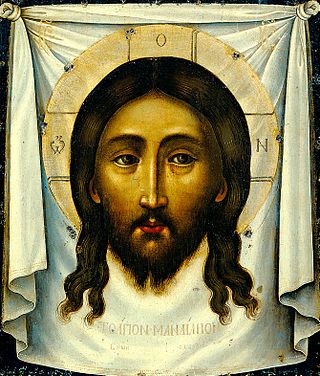
In digital imaging, a pixel, pel, or picture element is the smallest addressable element in a raster image, or the smallest point in an all points addressable display device. In most digital display devices, pixels are the smallest element that can be manipulated through software.

The RGB color model is an additive color model in which the red, green and blue primary colors of light are added together in various ways to reproduce a broad array of colors. The name of the model comes from the initials of the three additive primary colors, red, green, and blue.

The depiction of Jesus in pictorial form dates back to early Christian art and architecture, as aniconism in Christianity was rejected within the ante-Nicene period. It took several centuries to reach a conventional standardized form for his physical appearance, which has subsequently remained largely stable since that time. Most images of Jesus have in common a number of traits which are now almost universally associated with Jesus, although variants are seen.
Mass spectrometry (MS) is an analytical technique that is used to measure the mass-to-charge ratio of ions. The results are presented as a mass spectrum, a plot of intensity as a function of the mass-to-charge ratio. Mass spectrometry is used in many different fields and is applied to pure samples as well as complex mixtures.

A spectrum analyzer measures the magnitude of an input signal versus frequency within the full frequency range of the instrument. The primary use is to measure the power of the spectrum of known and unknown signals. The input signal that most common spectrum analyzers measure is electrical; however, spectral compositions of other signals, such as acoustic pressure waves and optical light waves, can be considered through the use of an appropriate transducer. Spectrum analyzers for other types of signals also exist, such as optical spectrum analyzers which use direct optical techniques such as a monochromator to make measurements.
A number of alleged relics associated with Jesus have been displayed throughout the history of Christianity. While some individuals believe in the authenticity of Jesus relics, others doubt their validity. For instance, the sixteenth-century philosopher Erasmus wrote about the proliferation of relics, and the number of buildings that could be constructed from wooden relics claimed to be from the crucifixion cross of Jesus. Similarly, at least thirty Holy Nails were venerated as relics across Europe in the early 20th century. Part of the relics are included in the so-called Arma Christi, or the Instruments of the Passion.

According to Christian tradition, the Image of Edessa was a holy relic consisting of a square or rectangle of cloth upon which a miraculous image of the face of Jesus had been imprinted—the first icon ("image"). The image is also known as the Mandylion (from Greek μανδύλιον "cloth, towel"), in Eastern Orthodoxy, it is also known as Acheiropoeiton, or "icon not made by hand".
Walter Cox McCrone Jr. was an American chemist who worked extensively on applications of polarized light microscopy and is sometimes characterized as the "father of modern microscopy". He was also an expert in electron microscopy, crystallography, ultra-microanalysis, and particle identification. In 1960 he founded the McCrone Research Institute, a non-profit educational and research organization for microscopy based in Chicago.

The Shroud of Turin, also known as the Holy Shroud, is a length of linen cloth bearing the negative image of a man. Some describe the image as depicting Jesus of Nazareth and believe the fabric is the burial shroud in which he was wrapped after crucifixion.

Secondo Pia was an Italian lawyer and amateur photographer. He is best known for taking the first photographs of the Shroud of Turin on 28 May 1898 and, when he was developing them, noticing that the photographic negatives showed a positive image of the man in the shroud in addition to a clearer rendition of the image. The image he obtained from the shroud has been approved by the Roman Catholic Church as part of the devotion to the Holy Face of Jesus.

A breathalyzer or breathalyser is a device for estimating blood alcohol content (BAC), or to detect viruses or diseases from a breath sample.
Lynn Picknett is a writer of books that are mainly about pseudo-religious history and popular conspiracy theories, the paranormal, the occult, and historical and religious mysteries.
Raymond N. Rogers was an American chemist who was considered a leading expert in thermal analysis. To the general public, however, he was best known for his work on the Shroud of Turin.

Acheiropoieta — also called icons made without hands — are Christian icons which are said to have come into existence miraculously; not created by a human. Invariably these are images of Jesus or the Virgin Mary. The most notable examples that are credited by tradition among the faithful are, in the Eastern church, the Mandylion, also known as the Image of Edessa, and the Hodegetria, and several Russian icons, and in the West the Shroud of Turin, Veil of Veronica, Our Lady of Guadalupe, and the Manoppello Image. The term is also used of icons that are only regarded as normal human copies of a miraculously created original archetype.

The Holy Face of Jesus is a title for specific images which some Catholics believe to be miraculously formed representations of the face of Jesus Christ. The image obtained from the Shroud of Turin is associated with a specific medal worn by some Roman Catholics and is also one of the Catholic devotions to Christ.

The Shroud of Turin, a linen cloth that tradition associates with the crucifixion and burial of Jesus, has undergone numerous scientific tests, the most notable of which is radiocarbon dating, in an attempt to determine the relic's authenticity. In 1988, scientists at three separate laboratories dated samples from the Shroud to a range of 1260–1390 AD, which coincides with the first certain appearance of the shroud in the 1350s and is much later than the burial of Jesus in 30 or 33 AD. Aspects of the 1988 test continue to be debated. Despite some technical concerns that have been raised about radiocarbon dating of the Shroud, no radiocarbon-dating expert has asserted that the dating is unreliable.

During its history, the Shroud of Turin has been subjected to repairs and restoration, such as after the fire which damaged it in 1532. Since 1578 the Shroud has been kept in the Royal Chapel of Turin Cathedral. Currently it is stored under the laminated bulletproof glass of an airtight case, filled with chemically-neutral gasses. The temperature and humidity controlled-case is filled with argon (99.5%) and oxygen (0.5%) to prevent chemical changes. The Shroud itself is kept on an aluminum support sliding on runners and stored flat within the case.

The History of the Shroud of Turin begins in the year 1390 AD, when Bishop Pierre d'Arcis wrote a memorandum where he charged that the Shroud was a forgery. Historical records seem to indicate that a shroud bearing an image of a crucified man existed in the possession of Geoffroy de Charny in the small town of Lirey, France around the years 1353 to 1357. The history from the 15th century to the present is well documented.

The Shroud of Turin Research Project refers to a team of scientists which performed a set of experiments and analyses on the Shroud of Turin during the late 1970s and early 1980s. STURP issued its final report in 1981.

The Shroud of Turin is a length of linen cloth bearing the imprint of the image of a man, and is believed by some to be the burial shroud of Jesus. Despite conclusive scientific evidence that it is of medieval origin, multiple alternative theories about the origin of the shroud dating it to the time of Christ have been proposed.







